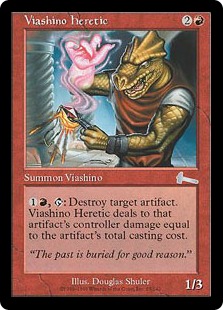It’s hard to forget the color that got you into the game. Whether you’ve been playing for 2 months or 20 years, for one reason or another one color caught your interest more than the others. Perhaps it’s because the color’s philosophy resonated with the way you preferred to play, or maybe it was simply the cards that color was showing off. As you continue to play, your tastes can change, your style evolves, and you branch out into more decks of different colors. That first color though, like a first love, will always resonate with you.
My first color was Red. That would surprise most people since my modern play style is so heavily Blue that I have a tendency to pull Blue-like shenanigans regardless of the color I’m using. What’s more, in my nineteen year span I’ve had periods where I’ve catered to all five colors. But I’ve always enjoyed Red.
At the start, Red was fascinating to me because it was powerful, direct, and easy for my 11-year old self to understand. That, and I had good luck getting some decent red cards. My first deck had the likes of Shivan Dragon, Rock Hydra, Fork, Disintegrate, and Lightning Bolts – all of which I still have a fondness for.
I also learned, of course, that Red was not perfect. It’s aggressive and potent, but also it’s fragile. This is especially true in multiplayer games, which was how we played even back then. As I grew to understand that, I tinkered with the deck constantly. I remember the thrill of cleverly putting down a Wall of Stone so I could defend myself while throwing spells about. I recall the excitement the day my older brother came home from the store with Iron Stars I asked him to get for me.
In time, though, I wanted to branch out. I really liked Sedge Troll, but I didn’t have access to Black. And I was always frustrated in dealing with the powerhouse card at the time known as Serra Angel. It was a pain to fend off without my dragon, but I also envied having my own because of just how darn efficient it was.
I eventually did get some Serras of my own, as well as starting to appreciate White’s lifegain abilities. My mono-Red deck became a Red/White deck, and it’s been with me ever since. I still take the time to update it on occasion with modern accoutrements, but it doesn’t see much use anymore. I keep it mostly as a reminder to my beginnings, and for those times when I feel like being a bit more direct in my games.
I haven’t forgotten my Red beginnings. As “tricksy” as I may get when playing, I can always appreciate elegance in simplicity because of that. White wants to gain life. Green wants to make stompy creatures. And Red wants to blow things up, be it creatures, players, or, as is the case here, artifacts.
Today we have: Viashino Heretic
Name: Viashino Heretic
Edition: Urza’s Legacy
Rarity: Uncommon
Focus: Artifact Destruction / Damage Dealing
Highlights: No one has quite the same love/hate relationship with artifacts like Red. Green wants to destroy them because they’re the antithesis of nature. White wants to get rid of them out of a desire for purification. Red wants to because they give players access to more options.
And Red is good at it; no other color is as efficient, or as sadistic, in taking out artifacts as Red. Cards like Viashino Heretic take it to an art form.
At a 1/3, it’s not the most fragile creature, which is nice to avoid small damage, which is useful given its activated ability. The heretic has Shatter on tap, which in and of itself is nice. So, when it adds in the ability to deal damage equal to that artifact’s converted mana cost, it’s a huge bonus when you consider that many artifacts used in Commander aren’t exactly cheap.
Of course, the irony is that you can make it even more potent with certain artifacts, but you don’t necessarily need to. Indeed the most you’ll usually have to consider about Viashino Heretic is when to cast him. It be put out as a passive threat to casting artifacts, or it can be held for a bit and cast if any problematic artifacts hit the battlefield that need to be on the receiving end of its special explosion powers. That’s about it.
So here’s to being to the point.
Keep an eye out for us to be regularly featuring other more accessible-but-worth-it Commander cards going forward. In the meantime, we’ll keep the light on for you.
![]()
You can discuss this article over on our forums!
Do you have a particular Commander card to suggest for us to shine a future Spotlight on? You can send suggestions to ryan@cardboardrepublic.com

